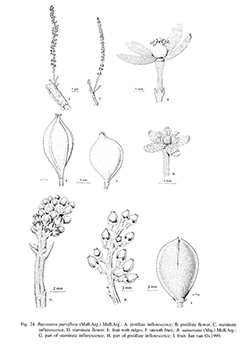e-Flora of Thailand
Volume 8 > Part 1 > Year 2005 > Page 113 > Euphorbiaceae > Baccaurea
8. Baccaurea parviflora (Müll.Arg.) Müll.Arg.wfo-0000305136
in DC., Prodr. 15(2): 462, 1866; Kurz, Forest Fl. Burma 2: 357. 1877; Hook.f., Fl. Brit. Ind. 5: 368. 1887; Airy Shaw, Kew Bull. 26: 220. 1972; Whitmore, Tree Fl. Malaya 2: 64. 1973; Airy Shaw, Kew Bull. Add. Ser. 4: 52. 1975; Haegens, Blumea Suppl. 12: 152, fig. 3. 18, map 3.26. 2000: Haegens & Welzen in Welzen et al., Thai Forest Bull., Bot. 28: 72. 2000.— Pierardia parviflora Müll.Arg., Linnaea 32: 82. 1863. Fig. 24: A-F.
Accepted Name : This is currently accepted.
Synonyms & Citations :
Description : Shrub to tree, up to 15 m high, candelabriform branching pattern strong; branchlets glabrous. Indumentum simple hairs. Stipules usually 2.5–7 by 1.5–2.5 mm. Leaves: petiole 4–55 mm long; blade elliptic to obovate, 5–23 by 2–9.5 cm, length/width ratio 1.6–3.7, papery, base attenuate to cuneate, lower surface without disc-like glands; nerves in (3–)5–10 per side. Staminate inflorescences cauliflorous, at base of trunk, many together, up to 28 cm long; bracts 0.3–1.6 mm long, bracteoles present. Staminate flowers 1–5 mm in diam.; pedicel 0.4–6 mm long; sepals 4 or 5, obovate, each with a different size and shape, 0.5–3 by 0.5–1.2 mm, red to yellow outside, cream to yellow inside, whitish outside; stamens 5–7, 0.5–0.9 mm long; filaments 0.4–0.8 mm long, straight; anthers 0.2–0.3 by 0.1–0.2 mm. Pistillate inflorescences cauliflorous, at base of trunk, many together, up to 28 cm long. Pistillate flowers 5–7.5 mm in diam.; pedicel 2–6(–9) mm long; sepals 4 or 5, narrowly elliptic to obovate, 2.7–8 by 0.9–2 mm, white to yellow to usually red; ovary with or without 6 wings, (2)3(4)-locular; style 0–2 by ca 1 mm; stigmas 0.1–1.5 mm long, cleft apically only or up to base. Fruits fusiform berries, often with 4–6 narrow longitudinal wings, 16–32 by 7–15 mm, dull red to maroon turning purple to black, (sub)glabrous outside, glabrous inside. Seeds 9–16 by 4–8 by 1–5 mm; arillode red to purple to white.
Thailand : SOUTH-WESTERN: Uthai Thani (Huai Kha Khaeng); PENINSULAR: Chumphon (Ta Ngo), Ranong (Klong Nakha, Khlong Nang Yon, Kraburi, Muang Len), Phangnga (Khao Phra Mi), Krabi (Khao Pra, Ko Lanta Yai), Nakhon Si Thammarat, Trang (Khao Chong, Ko Talibong), Satun, Songkhla (Khao Nam Kang, Kho Hong Hill), Pattani (Bukit), Narathiwat (Nikom Waeng).
Distribution : India (type), Malay Peninsula, Sumatra, Borneo.
Ecology : Primary and secondary evergreen forests, riverine forests, dipterocarp forests with much bamboo, gingers, and Donax grandis in undergrowths, on steep hillsides to dry parts of swamps, on sandstone to white sandy soil, 0–1,250 m alt.
Vernacular : mafai tao (มะไฟเต่า)(Satun); som fai din (ส้มไฟติน), som fai pa (ส้มไฟป่า)(Nakhon Si Thammarat); mafai ka (มะไฟกา)(Peninsular).
CommonName : Chinese lantern tree.
Uses: Fruit wall and arillode edible, sour-sweet. Wood used as box-wood.

